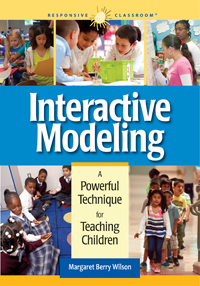A Powerful Teaching Model
Interactive Modeling: A Powerful Technique for Teaching Children
By Margaret Berry Wilson
(Responsive Classroom, 2012 – Learn more)
Sometimes I feel like I am a Responsive Classroom groupie. Each time a new book is released from the Northeast Foundation for Children, I want to be the first one in line to purchase it. My wallet becomes thinner and my bookcase overflows with great professional literature.
Margaret Berry Wilson’s new book, Interactive Modeling: A Powerful Technique for Teaching Children, is a case in point. I had the pleasure of reading this book during summer vacation and enjoyed the book so much that I immediately wanted to go into my classroom and begin to apply the strategies I had learned.
Wilson has written a powerful guide for teachers from PK to 8th grade that can help us improve our teaching of essential academic and social skills, as well as routines and behaviors. Wilson’s practical advice builds upon best practices that teachers may already apply in their classrooms, and introduces us to the highly useful Interactive Modeling concept. This research-based book includes sample lessons, scripts, a planning guide and links to video clips demonstrating Interactive Modeling in practice.
Comprehensive solutions to familiar problems

You know that you taught the skill or routine, reminded the students how to do it, and even created a poster or cute jingle to jog their memories. And then in November, they still ask you, “Where should I put my homework?” Or you look at their test papers and wonder where the complete sentences are, especially since the directions state to write in complete sentences.
Does it all sound familiar? It certainly was to me.
Wilson’s book is a true friend. It includes ways to address all these issues, and it’s there to help you when you need help, give you practical advice you can immediately use, and applaud your successes.
As I read the book, I felt as if I had a chance to observe a classroom in action while Ms. Wilson moderated the scenario for me. Her style of writing made the book easy to read and comprehend. She wove anecdotes and stories into each chapter, providing the reader with a sense of connection to other teachers and to the author.
The 7-Step Learning Process
When I read the scenario about teaching students how to paraphrase a research source, I began to wonder if Wilson had peeked into my lesson plans. Her seven-step model takes no more than seven minutes, but is efficient and effective.
Even though research is taught beginning in elementary school, when students come into my fifth grade classroom, many still think that if you change a word or two, you are not plagiarizing. This model of instruction will help them understand the right way to share what they’ve learned from research. It provides students with a clear and guided process they follow each time as the teacher is initiating, modeling, explaining, thinking aloud and showing.
The seven-step format not only shows children exactly what to do, it guides them into noticing key elements of the modeling lesson, and gives them opportunities for practice while the teacher coaches.
- 1. Describe a positive behavior you will model.
- 2. Model the behavior.
- 3. Ask students what they noticed.
- 4. Ask student volunteers to model the same behavior.
- 5. Ask students what they noticed.
- 6. Have the class practice.
- 7. Provide feedback.
We remember what we do ourselves
As I read the book, I thought of a maxim by my “dear old friend” Benjamin Franklin: Tell me and I forget. Teach me and I remember. Involve me and I learn. How often have we heard that people remember 20 percent of what they hear, 30 percent of what they see, 50 percent of what they hear and see, and 80 percent of what they hear, see, and do.
As Wilson explains, when the 7-step technique is used consistently in the classroom, children will quickly know what to do, they will remember better, and discipline problems will be at a minimum because students will be actively engaged independent learners. There will be more time on task and students will become responsible and active citizens of their classroom.
Ideas for all grade levels
Although many examples in the book are focused on an elementary classroom, Wilson provides the reader with guidelines to adapt the lessons for all levels and disciplines. Her book is not just a how-to book — a “warm and fuzzy book about teaching” — but a book that helps to build a caring, active, intellectually stimulating community of learners. It builds a classroom environment where the teacher wakes up in the morning and says, “I can’t wait to get to get to school today.”
Margaret Berry Wilson reminds us that the goal of the Interactive Modeling “isn’t compliance, but cooperation.” Her kind words of advice ring true: “Give Interactive Modeling a try, be patient, plan lessons carefully, reflect on how they went, and adjust as needed. …embrace your mistakes and the self-learning that results.”
I believe this is a book that should be in the hands of all teachers in the content areas, as well as teachers of English language learners, special area teachers, librarians, and administrators.
Linda Biondi is a fifth grade teacher at Pond Road Middle School in Robbinsville, New Jersey. She has written for Education World, the Responsive Classroom newsletter, and the ERIC Clearinghouse. She’s also the recipient of several grants that promote inquiry and a literacy enriched curriculum, and a consultant with the National Writing Project.




































Thank you, Linda, for your kind words about the book. It means so much to know that readers and teachers are finding it helpful. I appreciate your taking the time to describe the book and what you liked about it so clearly and in such detail!